- Learning time
- 60 minutes
- First play time
- 150 minutes
Terracotta Army
Designed by: Adam Kwapiński,Przemysław Fornal
In Terracotta Army the players are building the famous life-size figures of ancient China, constructing the clay soldiers one by one and placing them onto a grid to score points. Sounds simple? Well, yes and no…
The board is loosely divided into four quadrants, and for our purposes we’re mainly focusing on two of them: the action wheel and the mausoleum. The mausoleum is where the figures – plastic in this case – are placed once built. Over the game’s five rounds, you can score points round by round by meeting certain criteria: having warriors of a certain kind in the mausoleum (there are four different warriors) having warriors in a specific location and so on. There are also two Inspector pieces (-the red pawns) that march along the mausoleum, scoring points for the row and column they’re next to at the end of each round. In each case every player who meets the criteria will score points, but having the most warriors present gets you a not-inconsiderable bonus. You’ll also score for these at the end of the game as well, but we’ll come to that soon enough.
Meantime let’s turn our attention to the action wheel, because this is the engine that powers – one hopes – your progress. On your turn you place one of your craftsmen next to a segment of the wheel, taking the three actions it offers, starting at the hub and working to the outside. The actions are numerous, but most are quickly understood: get some coins, get some clay, spend clay to create a warrior (adding it to the mausoleum) or wet your clay: at the end of each round, any clay in your possession dries out and is temporarily unusable! You can spend coins to turn parts of the wheel if you like before taking actions, but only one way and only by a single spoke of the wheel. Usually a craftsmen at a section of wheel blocks it, but if you’ve upgraded your craftsmen to an artisan then the artisan can share already-occupied spaces.
That’s the nub of it: gather clay to build warriors. However, there are other cogs you can spin in your favour too. Masters – triggered by the wheel, and paid for with cash – give you ongoing benefits whenever you activate the matching master on the wheel. These let you buy warriors with cash (no clay needed) or get an influx of clay, or double an action and so on. Specialists are another kind of warrior that can be built: there are four (archer, musician, footman, horse) and each helps you score points: the archer scores points when placed, the footman could push ties in your favour later, the musician scores for the entire column and row it aligns with, and the horse simply takes up quite a lot of space, allowing you to muscle in on Inspector scoring, or connect disparate groups of warriors together. Again, the wheel is what gives you the opportunity to build a specialist: you just need to make sure you have the weapon you need.
Weapons are a kind of secondary economy at work after coins and clay. You’ve four different types of weapon, at the start of the game unavailable. Actions and/or Masters make them available, and when available they can give you a little boost when you build a warrior who uses that weapon – and you can’t build specialists at all without them! In theory you could play the entire game ignoring them, but they can be rather helpful…
After the fifth round is scored, there is some final scoring for presence in the mausoleum, then the player with the most points wins.
The guru's verdict
-
Take That!
Take That!
Players aren't attacking each other at all, but the placement of warriors in the mausoleum is critical to success: not only do you need to ensure you're scoring points, but ideally you want to hamper others from doing likewise.
-
Fidget Factor!
Fidget Factor!
Moderate to high. The available options on the wheel won't be known until your turn arrives, and even then you can still move things around by paying cash to rotate one of the inner rings. So for every few turns that might go at a reasonable pace, there'll be one or two lulls as plans B and C get considered.
-
Brain Burn!
Brain Burn!
Fairly high. Terracotta Army has a simple heart, but a complex nerve system around it that presents you with a plethora of options.
-
Again Again!
Again Again!
Huge replayability here, assuming a brain-burning puzzle is what you're after. The wheel itself has a random set-up and is constantly changing. The scoring criteria for each round change from game to game, and each player's decisions has ramifications for others.


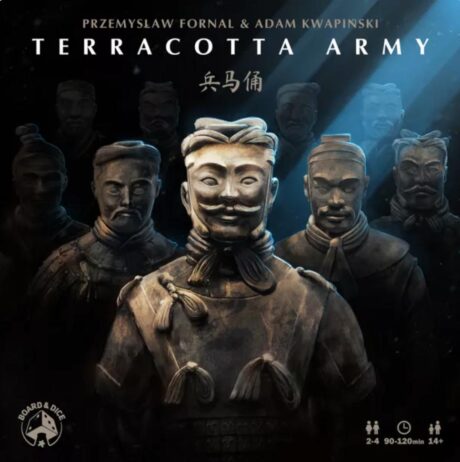
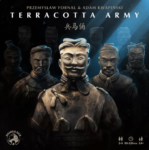
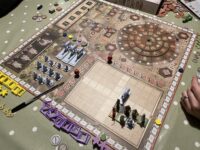
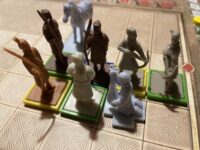

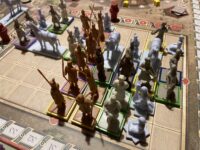
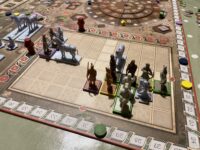

Sam says
A solid puzzle game, Terracotta Army bamboozled me on first sighting: it's a long game to play, and a fairly long game to teach as well. I'm not hugely drawn to either (with exceptions) but I like long games to have a sense of story, a dramatic arc, moments you talk about afterwards and maybe some swingy, tense moments and laughter. This has none of that - it's a puzzle; of spotting paths through the forest of options and maximising moments of opportunity. I'd play it again - that first encounter was mainly about coming to terms with what I was trying to achieve - but long, computational puzzles aren't generally my thing, so it's not something I'd actively seek out.